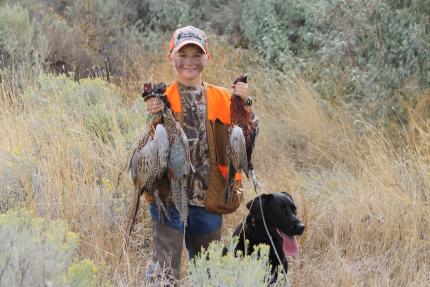
One of the biggest problems hunters face, and it’s especially true for those who are new to the sport, is finding productive places to hunt. If you’re looking for spots to hunt upland birds, here are some suggestions.
During the hunting seasons 2007 through 2011, Washington hunters harvested about 102,000 forest grouse, 98,500 quail, 62,000 pheasants, 11,500 chukar and 5,300 gray partridge a year. While both quail and forest grouse are available in a majority of Washington counties, chukar, gray partridge and (wild) pheasants are not, so a good place to start searching for hunting opportunities is to determine what regions of the state produce the highest harvests of the bird or birds you’re looking to hunt.
Grant County is the state’s top pheasant producer, averaging 12,000 birds harvested annually. Whitman County hunters harvested about 9,700 ring-necks a year over the past five years, followed by Walla Walla (7,100), Yakima (6,600) and Franklin (4,600) counties.
The best forest grouse hunting is found in the northeastern and north-central part of the state. Okanogan County led the way in grouse harvests over the past five years, with hunters taking more than 14,600 grouse a year. Stevens County was second at 13,300, followed by Ferry County at 8,300, Pend Oreille County at 5,400, and Western Washington’s Grays Harbor County at nearly 5,300.
Yakima County doesn’t have much competition as the best place in the state to hunt quail. Hunters there harvested an average of 25,000 quail annually over the past five years, nearly double the 13,000 birds taken in Grant County each year. Chelan County quail hunters averaged 8,900 quail a year, Okanogan County 8,800 and Douglas County 7,300.
As for the best places to pursue chukar partridge, five counties stand alone atop the list. Asotin, Chelan, Douglas, Kittitas and Yakima counties each produced an average of 1,500 to 1,700 chukars a year from 2007 through 2011.
Gray (Hungarian) partridge aren’t as abundant as the other upland species pursued by Washington hunters, but the best counties to look for them (and their average annual harvest over the past five years) are Grant (666), Whitman (642), Asotin (631), Okanogan (569) and Columbia (474).
The complete five-year-average upland bird harvest figures for all Washington counties are listed in the Washington State Migratory Waterfowl & Upland Game Seasons pamphlet.
The state’s public lands offer a variety of upland bird hunting options, including WDFW wildlife areas. The 192,000-acre Columbia Basin Wildlife Area, for example, includes over a dozen units, most of them offering good hunting opportunities for pheasant, quail and other upland species. Although much smaller, the Sunnyside/Snake River Wildlife Area and many of its 18 units are also worth investigating. The wildlife areas west of the Cascades also provide some upland bird hunting possibilities, both for forest grouse and for released pheasants.
WDFW releases pheasants in over 50 locations throughout the state, about half of them in Western Washington and half on the east side of the Cascades. Many of these pheasant release sites are in our state’s wildlife areas. Release site descriptions and driving directions are available on the Places to go hunting page.
Upland bird hunting opportunities also abound on several of the Northwest’s National Wildlife Refuges and on properties managed by the Bureau of Land Management.
Many of the state’s best upland bird hunting opportunities are found on private land. In Washington, hunters must obtain landowner permission to hunt on private land, but the Department of Fish and Wildlife is working with hundreds of landowners to help acquire permission. The WDFW private lands access program has over 600 landowner cooperators and over 1.2 million acres of private land under agreement in eastern and western Washington. Those programs are:
Feel Free to Hunt: Private lands where WDFW has a management agreement with the owner to provide public access for hunting. At last count more than 500,000 acres were available to hunters under this program, including more than 106,000 in Klickitat County, 62,000 in Benton County, 64,000 in Walla Walla County, 58,000 in Franklin County, 38,000 in Adams County and 37,000 in Grant County.
Register to Hunt: Private lands in which WDFW has a management agreement with the owner where hunting is regulated by registration. Some 20,000 acres are currently in the Register to Hunt Program, including 8,300 in Benton County, 5,500 in Garfield County and 4,000 in Douglas County.
Hunting by Written Permission: Private lands where hunters must contact the landowner to obtain “written permission” before hunting on their property. Over 550,000 acres are included in this program, 131,000 of them in Adams County alone. Douglas, Grant, Lincoln and Garfield counties also offer large tracts of Hunt by Written Permission property.
Landowner Permit: In some cases, landowners are allowed to work with the Department to set special hunting season dates on their property and have hunting opportunities on their lands customized. Hunting opportunity is available to hunt these lands through special permit drawings. Most of the property involved in this program is in Benton County and Grant County.
For more information on these programs, check out WDFW’s hunting access website. Also spend some time studying the Hunt Planner webmap for details on these and other places where upland bird hunting may be available.
If you want to strike out on your own to gain access to private property, do some scouting and door-knocking to get permission to hunt. Some landowners will refuse to grant permission, but persistent hunters will gain access to some lightly hunted areas and make new friends along the way.